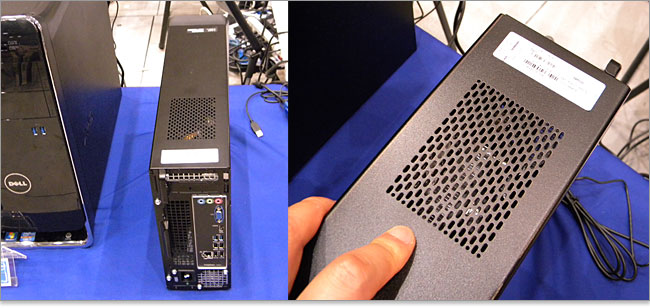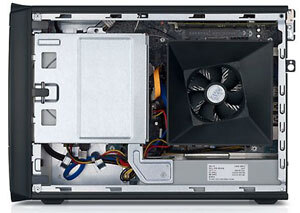- Mar 27, 2009
- 12,968
- 221
- 106
Recent price drops of some SFF parts got me thinking about how a budget DIY mITX PC compares to a mass produced budget SFF PC from a value standpoint.
While thinking about this, here are some factors/considerations in favor of the DIY PC that crossed my mind:
1. Overclocking and underclocking/undervolting: Possible with DIY depending on the components and manufacturer.
2. DIY uses standardized components (including motherboard) and thus can be re-built. Pre-Build SFF PC may or may not use standardized parts.
3. Windows 8 System builder is a re-usable component (through the personal use license) when purchased for DIY and thus can be transferred to subsequent builds. A mass produced Pre-built PC contains a version of Windows 8 that is tied to the motherboard (so even if the pre-built chassis and other components can be re-used, a new OS will need to be purchased if there is a mainboard swap.)
4. Price: Pre-built SFF PCs can often be found on sale, but deals exist for DIY as well (eg, Microcenter CPU deals, Frys CPU/motherboard bundle, Free 8 GB ram deals from Newegg with Biostar mainboard purchase, etc)
5. Warranty can be longer on individual DIY parts vs. brand new pre-built PC (Eg, a HP slimline carries a 1 year warranty, but many DIY parts (even cheap ones) carry warranties longer than that.)
6. A DIY SFF PC build does not come with bloatware.
7. A much greater amount of testing can be found online with regard to thermal and noise performance for DIY SFF cases vs. mass produced pre-built SFF (with the exception of certain Boutique Pre-builts). This could be important if the system needs to be upgraded.
8. A group of features may be needed for a SFF PC that cannot be found in a pre-built.
One obvious draw for DIY is overclocking, but even at the lowest price points (where the parts cant be overclocked on the Intel side) I think an argument can still be made for DIY mITX PC over the Pre-built SFF PC.
Example:
http://www.newegg.com/Product/Produc...82E16883155554
(Dell Inspiron i660-769BK Desktop, $289.99 for free shipping, 1 year limited warranty parts and labor.)
The above SFF PC is the cheapest I could find on Newegg. Here are some of the specs:
1. Celeron G465(1.9GHz)
2. 2GB DDR3
3. 500GB HDD
4. 16x DVD burner
5. Windows 8
6. Keyboard and mouse
7. 802.11 b/g/n wifi card
8. Usb 3.0
Here is a DIY SFF computer I pieced together (to best approximate the Dell SFF PC):
Motherboard:
http://www.amazon.com/dp/B0091158A6/?tag=pcpapi-20
(ECS H61 Mini ITX, $44.99 with free shipping, limited warranty 3 years for parts and 2 years for labor. NOTE: this board does not have a PCI-E x16 slot)
Or
http://www.amazon.com/dp/B0065SM75M/?tag=pcpapi-20
(Foxconn H61S Mini ITX, $49.99 with free shipping, limited warranty 3 years for parts and 3 years for labor.)
Or
http://www.macmall.com/p/6431245?dpn...ource=zwb12166
(Intel DH61DL Mini ITX board, $69.99 with free shipping, limited warranty 3 years for parts and 3 years for labor. NOTE: this board does not have a PCI-E x 16 slot, but does have USB 3.0)
CPU:
http://www.amazon.com/dp/B00B4BJYVU/?tag=pcpapi-20
(I couldnt find the Celeron G465 for sale at any of the major retailers, but this Celeron G1610 is faster and only $42.99 with Free shipping. 3 year warranty)
RAM:
http://www.amazon.com/dp/B006TTQGF4/?tag=pcpapi-20
(Wintec value ram 1 x 2GB, $16.06 with free shipping, limited lifetime warranty)
Hard drive:
http://www.amazon.com/dp/B000EY5F5C/?tag=pcpapi-20
(Seagate Barracuda 500 GB SATA HDD, $54.99 with Free shipping, 5 year warranty)
Optical drive:
http://www.newegg.com/Product/Produc...D=3938566&SID=
(Samsung Internal slim SATA DVD burner, $18.99 with free shipping, 1 year limited warranty)
Operating System:
http://www.amazon.com/Windows-System.../dp/B0094NY3R0
(Windows 8 system builder , 94.81 plus free shipping)
Case:
http://www.amazon.com/gp/product/B00...2?tag=at055-20
(Silverstone Sugo SG05 lite, $39.99 with free shipping, limited 1 year warranty)
PSU:
http://www.newegg.com/Product/Produc...089&nm_mc=AFC-
(Seasonic 300 watt SFX PSU, $39.94 after 15% promo code, $4.99 shipping, 3 year parts and labor warranty)
Total price (this includes shipping):
$357.76 for ECS miTX mainboard version
$362.76 for Foxconn mITX mainboard version
$382.76 for Intel mITX Mainboard version
When compared to the Dell SFF pre-built we have a price difference of $67.77 for the ECS mITX build. Substituting Foxconn and Intel mainboards (for the ECS) in the DIY build increases this difference by $5 and $25 respectively.
I dont think $67.77 more for the DIY build is bad at all (even at this value level) when we consider the extra advantages the DIY build has in certain scenarios.
NOTE: When comparing price of the DIY mITX builds to the Dell SFF realize the DIY builds do not come with wireless card, keyboard and mouse (and in the case of the ECS and Foxconn mainboards USB 3.0 is missing).
P.S. If anyone is wondering about case volume differences between the SG05 build and the Dell SFF PC here is what I came up with:
Internal volume of Dell SFF PC = 608 cubic inches
Internal volume of SG05 = 657 cubic inches
The SG05 has about 8% more case volume compared to the Dell SFF PC. Certainly the Dell SFF PC has a smaller footprint on the desktop compared to the Sugo. Still I thought the differences were minimal enough to include the SG05 in this comparison.
While thinking about this, here are some factors/considerations in favor of the DIY PC that crossed my mind:
1. Overclocking and underclocking/undervolting: Possible with DIY depending on the components and manufacturer.
2. DIY uses standardized components (including motherboard) and thus can be re-built. Pre-Build SFF PC may or may not use standardized parts.
3. Windows 8 System builder is a re-usable component (through the personal use license) when purchased for DIY and thus can be transferred to subsequent builds. A mass produced Pre-built PC contains a version of Windows 8 that is tied to the motherboard (so even if the pre-built chassis and other components can be re-used, a new OS will need to be purchased if there is a mainboard swap.)
4. Price: Pre-built SFF PCs can often be found on sale, but deals exist for DIY as well (eg, Microcenter CPU deals, Frys CPU/motherboard bundle, Free 8 GB ram deals from Newegg with Biostar mainboard purchase, etc)
5. Warranty can be longer on individual DIY parts vs. brand new pre-built PC (Eg, a HP slimline carries a 1 year warranty, but many DIY parts (even cheap ones) carry warranties longer than that.)
6. A DIY SFF PC build does not come with bloatware.
7. A much greater amount of testing can be found online with regard to thermal and noise performance for DIY SFF cases vs. mass produced pre-built SFF (with the exception of certain Boutique Pre-builts). This could be important if the system needs to be upgraded.
8. A group of features may be needed for a SFF PC that cannot be found in a pre-built.
One obvious draw for DIY is overclocking, but even at the lowest price points (where the parts cant be overclocked on the Intel side) I think an argument can still be made for DIY mITX PC over the Pre-built SFF PC.
Example:
http://www.newegg.com/Product/Produc...82E16883155554
(Dell Inspiron i660-769BK Desktop, $289.99 for free shipping, 1 year limited warranty parts and labor.)
The above SFF PC is the cheapest I could find on Newegg. Here are some of the specs:
1. Celeron G465(1.9GHz)
2. 2GB DDR3
3. 500GB HDD
4. 16x DVD burner
5. Windows 8
6. Keyboard and mouse
7. 802.11 b/g/n wifi card
8. Usb 3.0
Here is a DIY SFF computer I pieced together (to best approximate the Dell SFF PC):
Motherboard:
http://www.amazon.com/dp/B0091158A6/?tag=pcpapi-20
(ECS H61 Mini ITX, $44.99 with free shipping, limited warranty 3 years for parts and 2 years for labor. NOTE: this board does not have a PCI-E x16 slot)
Or
http://www.amazon.com/dp/B0065SM75M/?tag=pcpapi-20
(Foxconn H61S Mini ITX, $49.99 with free shipping, limited warranty 3 years for parts and 3 years for labor.)
Or
http://www.macmall.com/p/6431245?dpn...ource=zwb12166
(Intel DH61DL Mini ITX board, $69.99 with free shipping, limited warranty 3 years for parts and 3 years for labor. NOTE: this board does not have a PCI-E x 16 slot, but does have USB 3.0)
CPU:
http://www.amazon.com/dp/B00B4BJYVU/?tag=pcpapi-20
(I couldnt find the Celeron G465 for sale at any of the major retailers, but this Celeron G1610 is faster and only $42.99 with Free shipping. 3 year warranty)
RAM:
http://www.amazon.com/dp/B006TTQGF4/?tag=pcpapi-20
(Wintec value ram 1 x 2GB, $16.06 with free shipping, limited lifetime warranty)
Hard drive:
http://www.amazon.com/dp/B000EY5F5C/?tag=pcpapi-20
(Seagate Barracuda 500 GB SATA HDD, $54.99 with Free shipping, 5 year warranty)
Optical drive:
http://www.newegg.com/Product/Produc...D=3938566&SID=
(Samsung Internal slim SATA DVD burner, $18.99 with free shipping, 1 year limited warranty)
Operating System:
http://www.amazon.com/Windows-System.../dp/B0094NY3R0
(Windows 8 system builder , 94.81 plus free shipping)
Case:
http://www.amazon.com/gp/product/B00...2?tag=at055-20
(Silverstone Sugo SG05 lite, $39.99 with free shipping, limited 1 year warranty)
PSU:
http://www.newegg.com/Product/Produc...089&nm_mc=AFC-
(Seasonic 300 watt SFX PSU, $39.94 after 15% promo code, $4.99 shipping, 3 year parts and labor warranty)
Total price (this includes shipping):
$357.76 for ECS miTX mainboard version
$362.76 for Foxconn mITX mainboard version
$382.76 for Intel mITX Mainboard version
When compared to the Dell SFF pre-built we have a price difference of $67.77 for the ECS mITX build. Substituting Foxconn and Intel mainboards (for the ECS) in the DIY build increases this difference by $5 and $25 respectively.
I dont think $67.77 more for the DIY build is bad at all (even at this value level) when we consider the extra advantages the DIY build has in certain scenarios.
NOTE: When comparing price of the DIY mITX builds to the Dell SFF realize the DIY builds do not come with wireless card, keyboard and mouse (and in the case of the ECS and Foxconn mainboards USB 3.0 is missing).
P.S. If anyone is wondering about case volume differences between the SG05 build and the Dell SFF PC here is what I came up with:
Internal volume of Dell SFF PC = 608 cubic inches
Internal volume of SG05 = 657 cubic inches
The SG05 has about 8% more case volume compared to the Dell SFF PC. Certainly the Dell SFF PC has a smaller footprint on the desktop compared to the Sugo. Still I thought the differences were minimal enough to include the SG05 in this comparison.


















